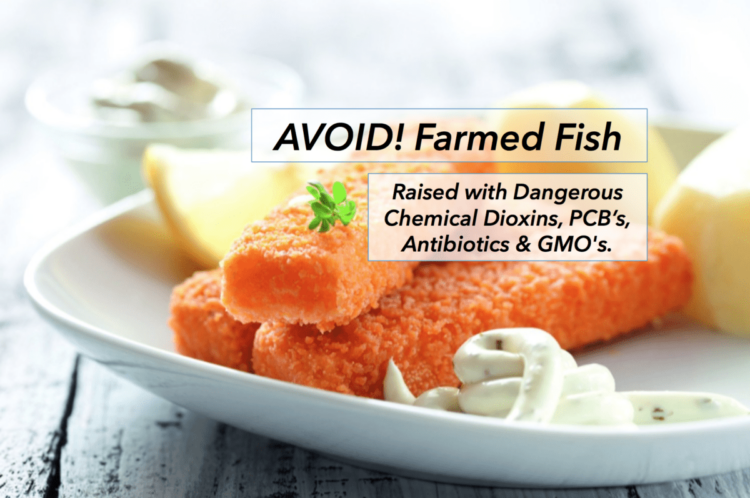Hidden toxins in farmed fish include GMO’s, Glyphosate, pesticides, herbicides, antibiotics, bacteria, chemicals, poisonous dioxins, PCBs, and other pollutants in dry pellet fish feed. Your Healthy Solution: Eat small wild fish such as Alaskan salmon and sardines.
Guest post by Dr. Joseph Mercola:
An Inside Look Into the Fish Industry Reveals Disturbing Facts That Could Threaten Your Health
Nicolas Daniel’s documentary “Fillet-Oh-Fish” takes a critical look at the fish industry, featuring exclusive footage from fish farms and factories across the globe. Many still have a rather romanticized view of fishing, but when it comes to large-scale food production, the picture is actually rather grim.
Today’s fisheries are faced with a range of severe problems, from overfishing to chemical pollution and genetic mutation from toxic exposures. As noted by the producers of the film, “through intensive farming and global pollution, the flesh of the fish we eat has turned into a deadly chemical cocktail.”1
Despite that, the fish business is booming, in part due to efforts to keep the dirty underbelly of modern fisheries from public sight.
Aquaculture promotes itself as a sustainable solution to overfishing. But in reality, fish farms actually cause more problems than they solve. There’s really little difference, in terms of environmental pollution, between land-based feedlots and water-based ones.
Farmed Salmon — One of the Most Toxic Foods in the World?
The film starts off in Norway, looking at the chemicals used in fish farms. Kurt Oddekalv is a respected Norwegian environmental activist, and he believes salmon farming is a disaster both for the environment and for human health.
Below the salmon farms dotted across the Norwegian fjords, there’s a layer of waste some 15 meters high, teeming with bacteria, drugs, and pesticides. In short, the entire sea floor has been destroyed, and since the farms are located in open water, the pollution from these farms is in no way contained.
A salmon farm can hold upwards of 2 million salmon in a relatively small amount of space. These crowded conditions result in disease, which spreads rapidly among the stressed salmon.
According to Oddekalv, sea lice, Pancreas Disease(PD)2 and Infectious Salmon Anemia Virus (ISA) have spread all across Norway, yet consumers are not informed of these fish pandemics, and sale of these diseased fish continue unabated.
A number of dangerous pesticides are used in an effort to stave off disease-causing pests, one of which is known to have neurotoxic effects. Fish has always been considered a health food, but according to Oddekalv, today’s farmed salmon is one of the most toxic foods in the world!
Toxicology researcher Jerome Ruzzin has confirmed Oddekalv’s claims. He’s tested a number of different food groups sold in Norway for toxins, and indeed, farmed salmon contains the greatest amount of toxins of them all, and by an incredibly large margin.
Overall, farmed salmon is five times more toxic than any other food product tested. In animal feeding studies, mice fed farmed salmon grew obese, with thick layers of fat around their internal organs. They also developed diabetes.
Ruzzin notes that a theory gaining traction is that rising rates of obesity is related to the increasing number of toxins and pollutants we’re exposed to through our environment and food. In light of his own studies, Ruzzin has stopped eating farmed salmon.
Genetic Mutations and Other Crazy Facts
Besides keeping pests like sea lice in check, the pesticides used also affect the fish’s DNA, causing genetic mutations. Disturbing examples of deformed cod are shown in the film.
What’s even more disturbing is that, according to Oddekalv, about 50 percent of farmed cod are deformed in this fashion, and female cod that escape from farms are known to mate with wild cod, spreading the genetic mutations and deformities into the wild population.
Farmed salmon suffer less visible but equally disturbing mutations. The flesh of the farmed salmon is “brittle,” and breaks apart when bent — a highly abnormal feature.
The nutritional content is also wildly abnormal. Wild salmon contains about 5 to 7 percent fat, whereas the farmed variety can contain anywhere from 14.5 to 34 percent.
Many toxins accumulate most readily in fat, which means even when raised in similarly contaminated conditions, farmed salmon will contain far more toxins than wild.
Shockingly, research reveals that the most significant source of toxic exposure is not actually the pesticides or the antibiotics, but the dry pellet feed! Pollutants found in the fish feed include dioxins, PCBs, and a number of different drugs and chemicals.
What Makes the Fish Feed so Toxic?
So what’s wrong with the fish feed? Why is it so toxic? In one Norwegian fish pellet plant, the main ingredient turns out to be eel, used for their high protein and fat content, and other fatty fish from the Baltic Sea.
That’s where the problem begins, as the Baltic is highly polluted. Some of the fish used have toxic levels of pollutants, which then simply get incorporated into the feed pellets.
In Sweden, fish mongers are now required to warn patrons about the potential toxicity of Baltic fish. According to government recommendations, you should not eat fatty fish like herring more than once a week, and if you’re pregnant, fish from the Baltic should be avoided altogether.
Swedish Greenpeace activist Jan Isakson reveals some of the sources of all this pollution. Just outside of Stockholm, there’s a massive paper mill on the bank of the Baltic that generates toxic dioxins.
Nine other industrialized countries surrounding the Baltic Sea also dump their toxic waste into this closed body of water. Dioxins bind to fat, which is why herring, eel, and salmon are particularly vulnerable, and end up accumulating higher amounts than other fish.
As a result of being deemed unfit for human consumption, some of these fatty fish are now primarily used as fish food. In this way, toxicity in the farmed salmon is allowed to build up even higher than in the wild.
One of the Best Kept and Most Dangerous Secrets of the Fish Industry
But there’s yet another problem, and it stems from the manufacturing process of the pellets. The fatty fish are first cooked, resulting in two separate products: protein meal and oil. While the oil has high levels of dioxins and PCBs, the protein powder further adds to the toxicity of the end product.
To the protein powder, they add an “antioxidant” called ethoxyquin. According to the filmmaker, this is one of the best kept secrets of the fish food industry. Ethoxyquin was developed by Monsanto in the 1950s — as a pesticide. Its use is strictly regulated, so why is it being added to fish pellets?
A couple of years ago, a Swiss anti-fraud laboratory was surprised to find extremely high levels of ethoxyquin in farmed fish — some 10 to 20 times higher than the 50 mcg per kilo allowed in food in the European Union — and that discovery began to unravel the secret. Ethoxyquin was designed for use on fruits and vegetables, but the fish feed industry discovered another novel use for it — they add it to the feed to prevent the fats from oxidizing and going rancid.
However, the fish feed manufacturers never informed health authorities of their use of the chemical. As a result, the EU strictly regulates ethoxyquin levels in fruits, vegetables, and meat — there are even standards for kangaroos and reptiles — but not for the fish people consume. What’s more, the effects of this chemical on human health have never been established.
The one and only study ever done on ethoxyquin and human health was a thesis by Victoria Bohne, Ph.D. a former researcher in Norway who made a number of disturbing discoveries, including the fact that ethoxyquin can cross the blood brain barrier, and may have carcinogenic effects. Bohne, as many other researchers who have made unpopular findings, was pressured to leave her research job after attempts were made to falsify and downplay her findings.
Others have linked the secret use of ethoxyquin in Norwegian fish farming, and the lack of scientific investigation into its effects, to the Norwegian Minister of Fisheries and Coastal Affairs, Lisbeth Berg-Hansen, who also happens to be a major shareholder in a commercial salmon farm, and has held many high-ranking positions within the fishing industry.
The Rise of Panga Exploited Fish Consumption
In France, fish consumption has more than doubled in the past five decades, now surpassing consumption of both beef and chicken. To meet demand, fish is being imported from around the globe. Rarely will you find a fish caught off the coast of France. Nearly half of all fish sold in France is raised in fish farms. Lesser known and less expensive species have also been brought to market.
Panga, which is now one of the 10 most consumed fish in France, was relatively unknown a decade ago. Its low price has also made panga a top seller in the school system. The questions asked in the film are, how can this farmed fish be sold at such low prices, and what’s actually in these fish that children are now eating on a regular basis?
The investigation begins in southern Vietnam, where panga is part of the culinary tradition. However, behind this cultural image, there’s a more disturbing reality. Over the past 15 years, panga exports have become a major source of income for the region. In fact, 95 percent of the global production of panga comes from southern Vietnam, and this success has resulted in both environmental and human exploitation.
Farmed panga grow twice to four times as fast compared to those in the wild, allowing them to reach adult size in about six months. The fish are then harvested and processed, which includes washing the fillets in big vats filled with water and polyphosphates — chemical additives that facilitate freezing.
The chemical also allows the fish to soak up water, which artificially increases their weight. After this process, the fish lack both taste and odor, and will take on the flavor of whatever spices you add to it during cooking.
Environmental Pollution Poses Risks
Many panga farms are plagued with disease, courtesy of the polluted waters in which they’re raised. Mekong River, where many panga farms are located, is one of the most heavily polluted rivers in the world. In 2009, the World Wide Fund for Nature placed panga on their “red” list of products that pose a danger to environmental and human health.
Millions of Vietnamese households dump their waste directly into the Mekong River each day. Pesticides used in rice cultivation also migrate into this waterway. Green algae and bacteria release toxins into the water and reduce oxygen levels in the water, which adds further stress on the fish’s immune systems, making them more prone to disease.
To address disease, farmers add industrial quantities of drugs into their fish ponds, including a wide array of antibiotics. The side effect is drug resistance, which forces the farmers to keep increasing the dosages. The panga are not the only thing affected by this strategy, of course. Antibiotics spread through the river systems, are absorbed into the fish’s tissues and excreted through feces, which redistributes the drugs into the environment — and to those who eat the fish.
Are You Eating Fish, or Fish Waste?
Fish can be one of the healthiest foods you can eat, but in the industrial age you have to be ultra careful about choosing the right type of fish. If you needed another reason to avoid processed foods, watch this film to the end, where it describes how fish waste has become a “highly valued commodity” used in processed foods. At less than 15 cents per kilo, these fish heads and tails, and what little meat is left over after filleting, is a real profit maker.
Virtually nothing actually goes to waste anymore. Fish skins are recycled for use in the cosmetics industry. The remainder of the fish waste is washed and ground into a pulp, which is then used in prepared meals and pet food.
Since food manufacturers are not required to tell you their products contain fish pulp rather than actual fish fillet meat, this product offers a high profit margin for food manufacturers. One tipoff: if the product’s list of ingredients includes a fish without specifyingthat it’s made with fillet of fish, it’s usually made with fish waste pulp.
Fish fraud is also commonplace. Investigations have shown that 1 in 3 fish labels are false or misleading. Typically, an inexpensive fish is mislabeled as a more expensive one. Some farmed fish are also passed off as wild. Since traceability is more complex in the processed food industry, due to the mixing of ingredients, that’s where most of the fish fraud occurs. It’s somewhat more difficult to pass off fillets of fish as another species, although that also occurs.
Best Seafood Options: Wild Alaskan Salmon, Sardines and Anchovies
It’s become quite clear that fish farms are not a viable solution to overfishing. If anything, they’re making matters worse, destroying the marine ecosystem at a far more rapid clip to boot … So what’s the answer? Unfortunately, the vast majority of fish — even when wild caught — is too contaminated to eat on a frequent basis. Most major waterways in the world are contaminated with mercury, heavy metals, and chemicals like dioxins, PCBs, and other agricultural chemicals that wind up in the environment.
This is why, as a general rule, I no longer recommend getting your omega-3 requirements from fish. However, I do make two exceptions. One is authentic, wild-caught Alaskan sockeye salmon; the nutritional benefits of which I believe still outweigh any potential contamination.
The risk of sockeye accumulating high amounts of mercury and other toxins is reduced because of its short life cycle, which is only about three years. Additionally, bioaccumulation of toxins is also reduced by the fact that it doesn’t feed on other, already contaminated, fish.
Alaskan salmon is not allowed to be farmed, and is therefore always wild-caught. My favorite brand is Vital Choice Wild Seafood and Organics, which offers a nice variety of high-quality salmon products that test high for omega-3 fats and low for contaminants. Canned salmon labeled “Alaskan salmon” is a less expensive alternative to salmon fillets.
The second exception is smaller fish with short life cycles, which also tend to be better alternatives in terms of fat content, such as sardines and anchovies, so it’s a win-win situation — lower contamination risk and higher nutritional value. A general guideline is that the closer to the bottom of the food chain the fish is, the less contamination it will have accumulated. Just make sure they’re not from the Baltic Sea.
Other good choices include herring and fish roe (caviar), which is full of important phospholipids that nourish mitochondrial membranes.





No Replies to "AVOID Farmed Fish with Chemical Dioxins, PCB's, GMO's."